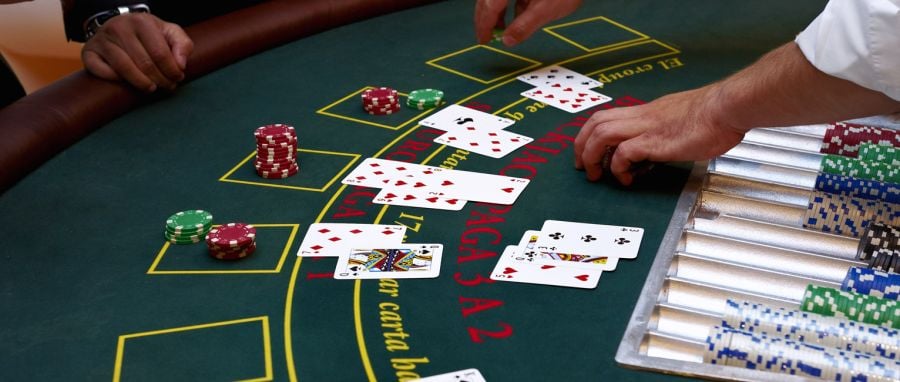Why Does the House Always Win in Blackjack?
Virtually all punters from around the world will have heard the saying 'The house always wins' at some point. While it's sometimes used as a metaphor, the statement is true and over time, casinos do win more than they lose. This applies to all of the games across their catalogue; however, in this article, we will be focusing on Blackjack, including both regular and live variations.
Before diving into this article, it's important to remember that the house always win.

The Concept of House Edge in Blackjack
Now, the reason that the casino wins over time is due to something known as the 'House Edge'. In short, it's the statistical advantage that the house has over all players, hence the name.
How The House Edge Works in Blackjack
In Blackjack, the house edge is a bit different from other casino games. While it's still based on the probability of success for each hand, the player's skill level can increase their chances of success. This is not the case with slots and other luck-based games such as online roulette. There are lots of other factors that contribute towards the house edge, too, covered later in this article.
Quantifying The Blackjack House Edge
Now, when it comes to actually calculating the house edge in Blackjack, it can be rather confusing. Luckily, this has already been worked out in the past, with standard variations having an average house edge of approximately 2.00%.
When playing standard online blackjack games, this house edge is checked by governing bodies, through third-party companies, on a regular basis to ensure that everything is fair for punters. This is achieved by taking the total amount wagered and comparing it to what was awarded to players throughout the specified period of time.
Factors Contributing to House Advantage in Blackjack
Players might think that in Blackjack, their hand either wins or loses, but of course, this is not the case, as a 'push' is also possible. However, even if it wasn't possible to draw in a round of Blackjack, the house would still have an advantage, due to the following factors:
Dealer's Advantage
One of the main reasons for a house edge being present is the dealer's advantage. In Blackjack, the dealer has a slight advantage because they always play their hand after the players have played theirs.
This means that it's possible for the player to lose their hand before the dealer acts, but the dealer cannot win before the dealer has their turn. Even if the player hits to 21, or even gets a blackjack, there's a chance that the dealer can draw, or even beat them.
It's worth mentioning that the dealer has no choice when it comes to their turn, either. All of their actions are specified within the rules of the game and thus, them acting last does not influence their decision-making process in any way.
Game Rules and Their Impact
Another factor that contributes to the house advantage in Blackjack is the game rules or the variation of Blackjack that you decide to play. While the rules vary from one casino to another, some common ones significantly affect the house edge.
For instance, if the dealer hits on a soft 17, the house edge increases. On the other hand, if the game allows the player to double after splitting, the house edge decreases. So, understanding the game rules and their impact can help you strategise better.
Role of Player Decisions
Another thing that can greatly impact the house edge is the decisions made by the player. While the average house edge in Blackjack is around 2.00%, some punters will be playing with higher, and others will enjoy a lower casino advantage.
Unlike in other games such as slots, baccarat, and roulette, there is an optimal way to play Blackjack, which can lower the house advantage to roughly 0.50%.
The Reality of Blackjack RTP
Another thing to consider when playing Blackjack is the RTP, or return to player rate, which is closely linked to the house edge.
What is the Return To Player Rate?
In simple terms, the return to player rate is the amount of all wagered funds that are distributed back to players, shown as a percentage. For example, if a blackjack return to player rate sits at 98.00%, it means that 98.00 of every 100.00 wagered, over time, will be distributed back in the form of winnings.
Adversely, this means that the house will keep 2.00 of every 100.00 made. Players can quickly work out the house edge of any given game, including Blackjack, by simply subtracting the RTP from 100%, with this stat being visible in the 'information' tab for most titles.
The Average Return To Player Rate for Different Blackjack Variations
As mentioned earlier, different rules and variations of Blackjack can significantly affect the house edge. Here's a look at the most popular versions of the game, including a brief overview of their rules and the RTP for each, should players be making the correct decisions at the table:
- American Blackjack - This is the standard variation of the game that many people will play before looking into other types of Blackjack. In most cases, it can come with an RTP of about 99.59%.
- European Blackjack - Next up is European Blackjack, where the dealer starts the hand with only one card. This doesn't impact gameplay too much, however, the rules are also tweaked slightly, with two decks being used and players only being able to split their hands once. The return to play rate with European Blackjack weighs in at 99.64%.
- Single Deck Blackjack -As the name suggests, single deck blackjack uses just one deck. In most land-based and online casinos, this offers the most favourable rules to the player, with an RTP rate of up to 99.85%.
- Double Exposure Blackjack - Last but not least is a rather unique variation of Blackjack, known as double exposure. Both of the dealer's cards are shown to players before they act, which can make decision-making easier. However, blackjacks are awarded at 1:1, or even money. The RTP for this game comes in at 99.33%.
While these variations of Blackjack vary slightly in terms of RTP rates, they are still better than most online slots and other table games, such as Roulette and Baccarat.
Strategies to Minimise the House Edge in Blackjack
Naturally, when players know the house edge of any blackjack variation, they then look for ways to minimise it. Here are a few strategies that players can implement into their game to do exactly that!
Card Counting
Did you know that card counting is one of the most effective ways to lower the house edge in Blackjack? It involves keeping track of the proportion of high to low cards left in the deck. It can significantly increase your RTP, thereby reducing the house advantage in Blackjack. Just remember, card counting requires practice and only works at land-based venues.
Basic Blackjack Strategy
This strategy is all about making the best decision for each hand, like when to hit, stand, split, or double down. Basic strategy isn't just a guess, it's been calculated by simulating millions of different blackjack hands in order to find the optimal decision in each situation. Following this strategy can significantly reduce the blackjack house edge if players follow it perfectly.
Carefully Selecting Your Blackjack Table
Finally, considering the rules of a blackjack table before sitting down is key. Here are a few things to look out for before placing a bet:
- The payout for a blackjack (Standard is 3:2)
- How many decks are being used in the game
- The specified return to player rate
- How many times a player can split their hand
- When a player can split their hand
- At what point players can double down
All of the above rules can influence the house advantage in Blackjack, so finding favourable rules is always a good idea.
Conclusion
In conclusion, the house always wins in Blackjack due to an advantage being built into each game. This mainly stems from the factor that players have to act before the dealer; however, the decisions made by those at the table, alongside the rules of each game can also have a huge impact.
For anyone who wants to decrease this house edge as much as possible, learning basic strategy could be the easiest way of doing so. It's a simple chart that many people can memorise in less than a week. When using basic strategy without any errors, the blackjack house edge could be reduced to just 0.15%, or even lower in unique circumstances.
Regardless of the strategy and type of Blackjack you decide to play, be sure to always set limits for a session, as staying safe when placing bets is crucially important. When playing Blackjack online, why not use our range of responsible gambling tools? These include deposit limits, player breaks, and betting limits, alongside many other features!








